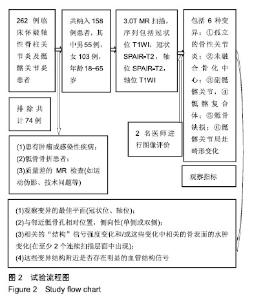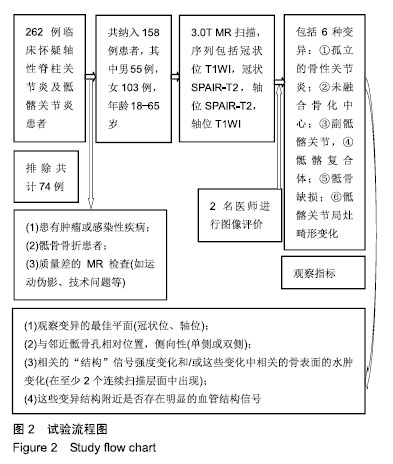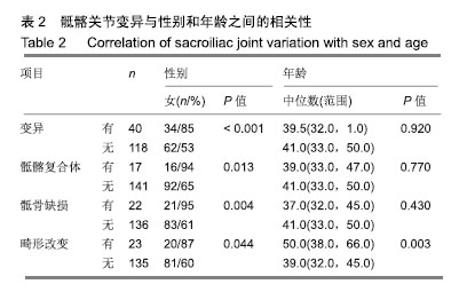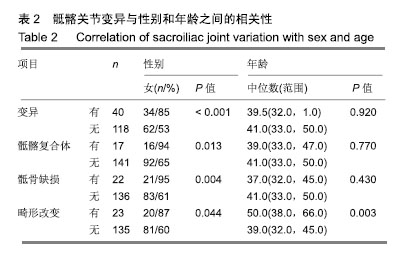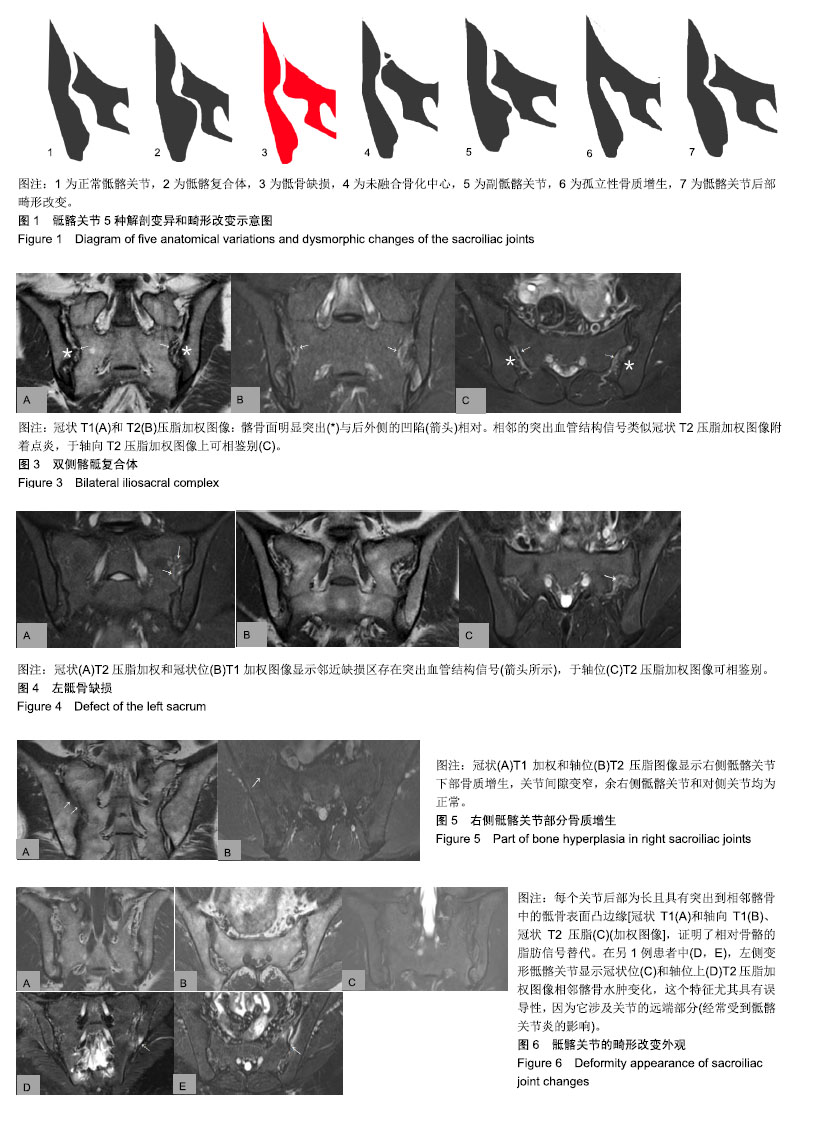| [1]Laloo F, Herregods N, Varkas G, et al.MR signal in the sacroiliac joint space in spondyloarthritis:a new sign. Eur Radiol. 2017;27(5):2024-2030.[2]Ruyssen-Witrand A, Luxembourger C, Cantagrel A, et al. Association between IL23R and ERAP1 polymorphisms and sacroiliac or spinal MRI inflammation in spondyloarthritis: DESIR cohort data. Arthritis Res Ther. 2019;21(1):22.[3]Anna D,Eva K,Mats G,et al.A five-year prospective study of spinal radiographic progression and its predictors in men and women with ankylosing spondylitis. Arthritis Res Ther. 2018; 20(1):162.[4]Kim HS, Yoon YC, Sung KS, et al. Comparison of T2 Relaxation Values in Subtalar Cartilage between Patients with Lateral Instability of the Ankle Joint and Healthy Volunteers. Eur Radiol. 2018;28(10):4151-4162. [5]任翠,朱巧,陈雯,等.弥散加权成像对强直性脊柱炎骶髂关节炎活动性判断的价值[J].中国医学科学院学报,2018,40(6):723-729.[6]Zhang G, Li J, Xia Z, et al. The gait deviations of ankylosing spondylitis with hip involvement. Clin Rheumatol. 2019;(12): 1-13.[7]徐琳,钟玉敏,胡立伟,等.DWI诊断儿童附着点炎症相关关节炎的早期骶髂关节炎性病变[J].中国医学影像技术, 2018,34(12): 1865-1868.[8]李贝贝,任翠萍,李莹,等.MRI DWI序列显示健康志愿者骶髂关节成像的最佳b值[J].中国组织工程研究,2013,17(17):3124-3131.[9]Braun J, van den Berg R, Baraliakos X, et al. 2010 update of the ASAS/EULAR recommendations for the management of ankylosing spondylitis. Ann Rheum Dis. 2011;70(6):896-904.[10]Plagou A, Teh J, Grainger AJ, et al. Recommendations of the ESSR arthritis subcommittee on ultrasonography in inflammatory joint disease. Semin Musculoskelet Radiol. 2016;20(05):496-506.[11]杜明珊,谢兵,熊宣淇,等.磁共振成像Dixon序列评价强直性脊柱炎患者骶髂关节骨髓水肿的价值[J].第三军医大学学报, 2018, 40(22):2081-2086.[12]吴晓涛,李传俊,伍鑫,等.磁共振成像对强直性脊柱炎早期骶髂关节炎诊断的临床应用价值[J].昆明医科大学学报, 2017,38(3): 98-102.[13]Ehara S, Elkhoury GY, Bergman RA. The accessory sacroiliac joint: a common anatomic variant. Am J Roentgenol. 1988; 150(4):857.[14]Egund N, Jurik AG. Anatomy and histology of the sacroiliac joints. Semin Musculoskelet Radiol. 2014;18(3):332-339.[15]Postacchini R, Trasimeni G, Ripani F, et al. Morphometric anatomical and CT study of the human adult sacroiliac region.Surg Radiol Anat. 2017;39(1):85-94.[16]杨金星,刘黎军,陈宏贤,等.骶髂骨间韧带的解剖及生物力学分析[J].中国实用医学,2015,10(29):28-30.[17]Rana SH, Farjoodi P, Haloman S, et al .Anatomic evaluation of the sacroiliac joint: a radiographic study with implications for procedures. Pain Physician. 2015; 18(6):583.[18]刘博,史大鹏,郑福增,等.MRI不同序列对骶髂关节软骨成像的比较[J].中国组织工程研究,2015,19(51):8223-8227.[19]Benz RM, Daikeler T, Mameghani AT, et al. Synostosis of the sacroiliac joint as a developmental variant, or ankylosis due to sacroiliitis. Arthritis Rheumatol. 2014;66(9):2367-2367.[20]Demir M, Mavi A, Gümüsburun E, et al. Anatomical variations with joint space measurements on CT. Kobe J Med Sci. 2007; 53(5):209-217.[21]Prassopoulos PK, Faflia CP, Voloudaki AE, et al. Sacroiliac joints: anatomical variants on CT. J Comput Assist Tomogr. 1999;23(2):323-327. [22]Vleeming A, Schuenke MD, Masi AT, et al. The sacroiliac joint: an overview of its anatomy, function and potential clinical implications. J Anat. 2012;221:537-567.[23]Maksymowych WP, Wichuk S, Dougados M, et al. MRI evidence of structural changes in the sacroiliac joints of patients with non-radiographic axial spondyloarthritis even in the absence of MRI inflammation. Arthritis Res Ther. 2017; 19(1):126.[24]Klang E, Lidar M, Lidar Z, et al. Prevalence and awareness of sacroiliac joint alterations on lumbar spine CT in low back pain patients younger than 40 years. Acta Radiologica. 2016: 0284185116656490.[25]Fortin JD, Ballard KE. The frequency of accessory sacroiliac joints. Clin Anat. 2010;22(8):876-877. [26]Bakker PA, van den Berg R, Lenczner G, et al. Can we use structural lesions seen on MRI of the sacroiliac joints reliably for the classification of patients according to the ASAS axial spondyloarthritis criteria Data from the DESIR cohort. Ann Rheum Dis. 2017;76(2):392-398. [27]王新芳. 86例未分化脊柱关节病临床分析[D].长春:吉林大学, 2011.[28]Flouri ID, Markatseli TE, Boki KA, et al. Comparative analysis and predictors of 10-year tumor necrosis factor inhibitors drug survival in patients with spondyloarthritis: first-year response predicts longterm drug persistence. J Rheumatol. 2018;45(6): 785.[29]林天武,牛丽萍,李军霞,等.育龄女性未分化脊柱关节病患者骶髂关节的CT影像特点[J].中国临床解剖学杂志,2016,34(2): 176-179.[30]Jans L, Langenhove C , Lambrecht V, et al. Diagnostic value of pelvic enthesitis on MRI of the sacroiliac joints in spondyloarthritis. Eur Radiol. 2014;24(4):866-871. |
